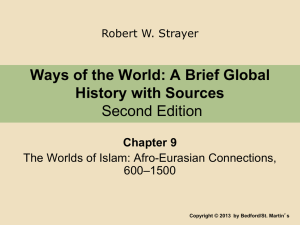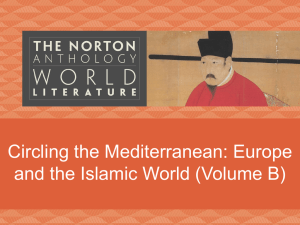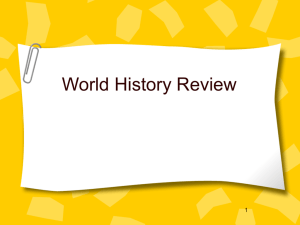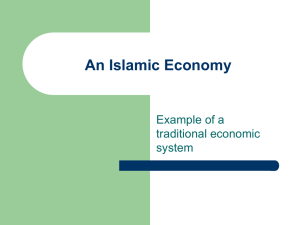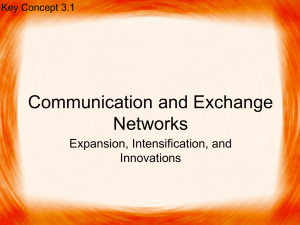All You Need to Know - Post
advertisement
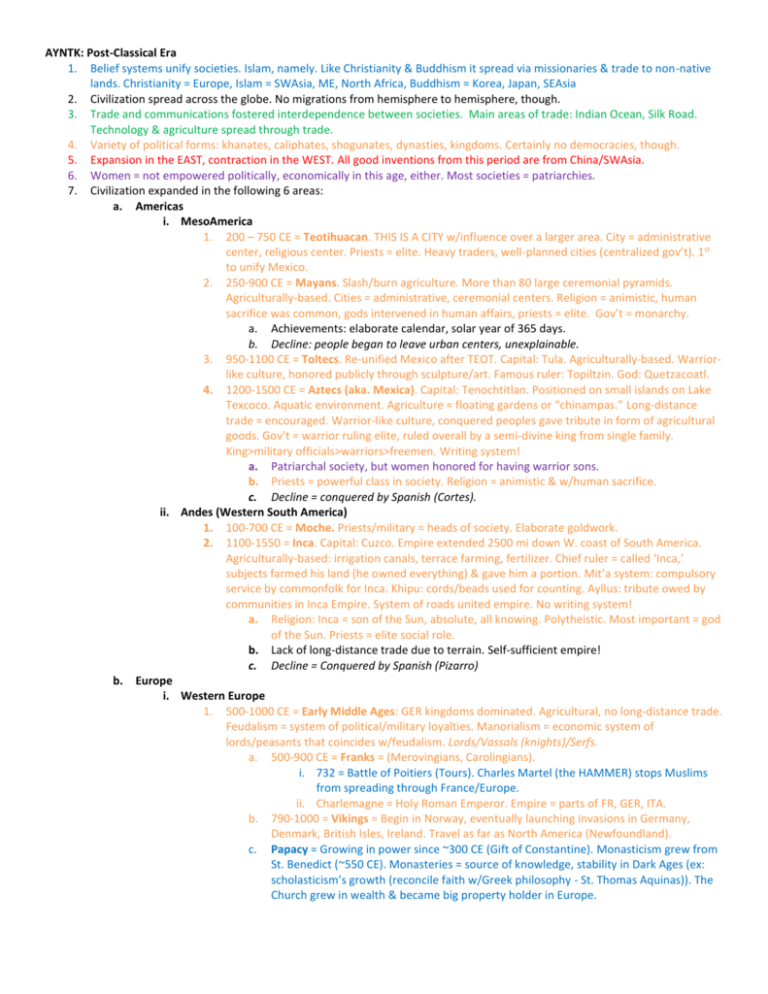
AYNTK: Post-Classical Era 1. Belief systems unify societies. Islam, namely. Like Christianity & Buddhism it spread via missionaries & trade to non-native lands. Christianity = Europe, Islam = SWAsia, ME, North Africa, Buddhism = Korea, Japan, SEAsia 2. Civilization spread across the globe. No migrations from hemisphere to hemisphere, though. 3. Trade and communications fostered interdependence between societies. Main areas of trade: Indian Ocean, Silk Road. Technology & agriculture spread through trade. 4. Variety of political forms: khanates, caliphates, shogunates, dynasties, kingdoms. Certainly no democracies, though. 5. Expansion in the EAST, contraction in the WEST. All good inventions from this period are from China/SWAsia. 6. Women = not empowered politically, economically in this age, either. Most societies = patriarchies. 7. Civilization expanded in the following 6 areas: a. Americas i. MesoAmerica 1. 200 – 750 CE = Teotihuacan. THIS IS A CITY w/influence over a larger area. City = administrative center, religious center. Priests = elite. Heavy traders, well-planned cities (centralized gov’t). 1st to unify Mexico. 2. 250-900 CE = Mayans. Slash/burn agriculture. More than 80 large ceremonial pyramids. Agriculturally-based. Cities = administrative, ceremonial centers. Religion = animistic, human sacrifice was common, gods intervened in human affairs, priests = elite. Gov’t = monarchy. a. Achievements: elaborate calendar, solar year of 365 days. b. Decline: people began to leave urban centers, unexplainable. 3. 950-1100 CE = Toltecs. Re-unified Mexico after TEOT. Capital: Tula. Agriculturally-based. Warriorlike culture, honored publicly through sculpture/art. Famous ruler: Topiltzin. God: Quetzacoatl. 4. 1200-1500 CE = Aztecs (aka. Mexica). Capital: Tenochtitlan. Positioned on small islands on Lake Texcoco. Aquatic environment. Agriculture = floating gardens or “chinampas.” Long-distance trade = encouraged. Warrior-like culture, conquered peoples gave tribute in form of agricultural goods. Gov’t = warrior ruling elite, ruled overall by a semi-divine king from single family. King>military officials>warriors>freemen. Writing system! a. Patriarchal society, but women honored for having warrior sons. b. Priests = powerful class in society. Religion = animistic & w/human sacrifice. c. Decline = conquered by Spanish (Cortes). ii. Andes (Western South America) 1. 100-700 CE = Moche. Priests/military = heads of society. Elaborate goldwork. 2. 1100-1550 = Inca. Capital: Cuzco. Empire extended 2500 mi down W. coast of South America. Agriculturally-based: irrigation canals, terrace farming, fertilizer. Chief ruler = called ‘Inca,’ subjects farmed his land (he owned everything) & gave him a portion. Mit’a system: compulsory service by commonfolk for Inca. Khipu: cords/beads used for counting. Ayllus: tribute owed by communities in Inca Empire. System of roads united empire. No writing system! a. Religion: Inca = son of the Sun, absolute, all knowing. Polytheistic. Most important = god of the Sun. Priests = elite social role. b. Lack of long-distance trade due to terrain. Self-sufficient empire! c. Decline = Conquered by Spanish (Pizarro) b. Europe i. Western Europe 1. 500-1000 CE = Early Middle Ages: GER kingdoms dominated. Agricultural, no long-distance trade. Feudalism = system of political/military loyalties. Manorialism = economic system of lords/peasants that coincides w/feudalism. Lords/Vassals (knights)/Serfs. a. 500-900 CE = Franks = (Merovingians, Carolingians). i. 732 = Battle of Poitiers (Tours). Charles Martel (the HAMMER) stops Muslims from spreading through France/Europe. ii. Charlemagne = Holy Roman Emperor. Empire = parts of FR, GER, ITA. b. 790-1000 = Vikings = Begin in Norway, eventually launching invasions in Germany, Denmark, British Isles, Ireland. Travel as far as North America (Newfoundland). c. Papacy = Growing in power since ~300 CE (Gift of Constantine). Monasticism grew from St. Benedict (~550 CE). Monasteries = source of knowledge, stability in Dark Ages (ex: scholasticism’s growth (reconcile faith w/Greek philosophy - St. Thomas Aquinas)). The Church grew in wealth & became big property holder in Europe. 2. 1000-1500 CE = High Middle Ages: growth of European towns, small cities, accelerated trade w/East; middle class/merchant class grows by end of period across Europe. Merchant classes gained greater political status w/wealth. a. 1096-1200 = Crusades = 1st 4 (of 8 total) Crusades tried to secure pilgrimage routes from WEUR to Holy Land. 1st Crusade = only one that works. Legacy of Crusades = awakened EUR to eastern ideas/technologies/art/goods. Venice/Genoa benefit from Crusades, as they ship men from WEUR to Holy Land, shipped goods back to WEUR. Profit!!!!! b. 1080 = Christianity splits. Latin West (w/Pope), Orthodox East (w/Patriarch). c. England = 1215 Magna Carta (nobles lobbied king w/grievances).Creation of parliaments d. Hanseatic League = trade alliance of northern GER/Scandanavian feudal lords/manors. e. 1350-1450 = Hundred Years’ War = idea of the ‘state’ grows in ENG, FR after bitter war. ENG, FR monarchies rise at expense of nobles. ii. Byzantine (Eastern Roman) Empire. Keeps Roman culture/society alive in East. Decline in 12th century. 1. 527-562 = Justinian. Corpus Iuris Civilus = MASSIVE Codification of Roman law. Builds Hagia Sophia. Caesaropapism = BYZ emperor was head of church/state. Bureaucratic government, controlled BYZ economy. 2. 600-1450 = BYZ under constant attack from all sides. Muslims, Arabs, Slavs. BYZ survived, though. 3. Women – paterfamilias controlled daily life, confined to home (empresses had power: Theodora) 4. Basic literacy widespread. Constantinople = center of learning. Preserved Classical legacy. Christianity spread from Constantinople to Slavic areas, Russia, Bulgaria, Poland. Cyrillic alphabet. 5. 1453 = Fall of Constantinople to Ottoman Turks (then renamed to Istanbul). Byzantines done. c. Islam i. 622 CE = Founded by Muhammad after flight to Medina (hijrah). Arabian Peninsula: Bedouin (tribal) culture = culture of Mohammed/Arabian Peninsula. Mecca/Medina/Jerusalem = 3 most holy places in Islam. Ka’ba = black stone. Umma = global Islamic community. Abu Bakr = Muhammad’s successor & close friend. Abu Bakr launched raids into Egypt, MPT, Syria. ii. 661-750 CE = Ummayad Caliphate. Ali (Muhammad’s cousin, son-in-law, 4th caliph or ruler) assassinated. Ali’s supporters = Shi’ite, believed all Muhammad’s successors must be related to Muhammad. Sunni = successor can be anyone appointed by council of elders/leaders (majority of Muslims). Capital of Islam at this time = Damascus. 733 CE = Islamic empire spreads all the way from Spain in the West to India in the East. Tolerant to ‘people of the book’ (Jews/Christians), non-Muslims still had to pay a tax. Non-Arabs were politically/socially disenfranchised, popular discontent eventually brought down Ummayads. iii. 750-1258 CE = Abbasid Caliphate – GOLDEN AGE OF ISLAM. Capital at Baghdad. More welcoming to dhimmis (people of the book) and non-Arab subjects (mawali). Opened up Islam to all, not just Arabs; made for cosmopolitan mix of cultures. Governments changed within the Islamic world, but not the faith (‘glue’ keeping it together). Trade on Indian Ocean (IndOc), Trans-Sahara, Silk Road = thriving. Works of Greek/Roman science & philosophy maintained by Islamic scholars. 1. Innovations = dhows (ships w/lateen sails, good on IndOc); Arabic numerals; al-jabr (algebra) 2. Decline = began ~800 CE. Central control in Baghdad was difficult, empire was large. Abbasids depended on Seljuk Turks to defend borders, serve in Abbasid army. By mid 1100’s Seljuks appointed sultans more powerful than the Abbasid caliph. Abbasids fully destroyed by Mongols after Baghdad captured in 1258. iv. India 1. 1206-1526 CE = Delhi Sultanate. Islamic regime ruling over Hindus. Capital at Delhi. Sultans weren’t Indian. Military control. Conversion to Islam was voluntary. Merchants spread faith, also Sufi mystic missionaries. Some Hindus converted to escape low castes, avoid non-Muslim tax. Hindus/Muslims lived different social lives in exclusion of each other. Hinduism/Islam = opposites (Islam = equality, Hinduism = caste system; Islam = monotheistic, Hinduism = polytheistic). v. Islam spreads further into SE Asia and Africa via trade. Dar-al-Islam and Pax Mongolica (Mongol peace) = great for worldwide travel & trade. d. Central Asia i. 1200-1300 = United Mongols. Single empire. Conquer China (1279), Russia, Persia, MPT. 1. Genghis dies, empire split into 4. Khanate of the Great Khan (Mongolia + CHI), Khanate of Jagadai (Central Asia, just north of India), Khanate of the Golden Horde (Central Asia & Russia), Il-Khan (Persia & MPT). Pax Mongolica (Mongol peace) = great for travel, communication. Kept commerce/communication open between East/West (esp. Silk Road!). Downside = Black Death spread b/c interactions between E/W were possible. 2. Mongols = central Asian nomads. Great on horseback, great bowmen. Decentralized empire. e. f. ii. 1300-1400 = Pax Mongolica in pieces. CHI, RUS, Persia, MPT lands all separated. Divided by infighting between Golden Horde and Il Khans. Other reason – Mongol leaders adopted customs of the ruled (i.e. Mongol rulers in MPT/Persia adopted Islam). Empire gone by 1400. East Asia i. China 1. 590-620 = Sui. Reunified China. Built the Grand Canal. 2. 620-910 = Tang. Capital: Chang’an. Confucians. Repair Great Wall, extended Chinese borders westward. Conquered Silla (in Korea). Han examination system/bureaucracy/scholar-gentry greatly used & expanded. Aristocrats = out of power b/c of equal field system (broke land inheritance for royals). Wu Zhao – female emperor. a. Silk Road = massive. Eastern terminus = Chang’an. Made Chang’an cosmopolitan, wealthy, & heavily populated (2,000,000 people in/around city). INDIAN OCEAN TRADE. b. Buddhism = important along w/Confucianism. Traveling monk = Xuanzang (traveled to India, brought back Buddhist texts, translated). c. Decline = peasant rebellions caused Tang officials to blame Buddhists; northern invasions by Uighurs; regional military leaders became too powerful. 3. 960-1280 = Song (Northern: 960-1130, Southern: 1130-1280). Scholar-gentry more important than ever. Neo-Confucians. Fought often w/Northern tribes (Jin). Women = subordinated, epitome = footbinding. Song known for economic changes that revolutionized China: a. Industry: paper/book production. Ceramics. STEEL (big military advantage). Gunpowder. Block printing. b. Commerce: ‘flying money’ (Song credit cards). Paper money. Large ships = higher trade capacity, frequency. Compass. INDIAN OCEAN TRADE. c. Agriculture: Champa rice – fast-maturing, led to quicker, better surpluses. 4. 1280-1370 = Yuan (Mongols). Founded by Kubilai Khan. Buddhists. Dismantled Han Confucian examination system, favored Mongols in gov’t positions over old scholar-gentry. Favored merchants, physicians as well, promoting trade/medical knowledge. ii. Korea/Japan/Vietnam 1. Korea = Silla/Koryo = vassal states to Tang/Song. Vietnam = modeled itself after Chinese state. Japan = Fujiwara family. Ruling families protected emperor. Feudalism = emperor>daimyo>samurai>commonfolk. Bushido code. Shintoism. Africa i. Sub-Saharan Africa 1. 700-1100 = Ghana. GOLD. Converted to Islam in 900’s, Muslim merchants poured in. Defeat by Muslim berbers (Almoravids) in 1076 led to decline (gold supply dried up as well). 2. 1200-1450 = Mali. Sundiata = founder, legend (griots kept story alive). Large army. Larger kingdom than Ghana. Trading state that controlled commerce through West Africa. Mali kings = Muslim, people = animistic. Mansa Musa = famous Muslim ruler, made hajj to Mecca, brought back Islam to subjects, new arts/architecture/sciences from East, made Mali cosmopolitan. 3. 1450-1600 = Songhay. New gold sources brought wealth. Sunni Ali = most famous ruler. Islamic state. Defeated in 1591 by Moroccan army w/muskets. ii. East Africa 1. 1200-1400 = Swahili States. Collection of trade-rich city-states down E. Africa coast, BIG ON TRADE. Chinese, Middle Easterners wanted gold, iron, timber, ivory, animal hides from E. Africa. Language = Swahili. Conversion to Islam via trade (better trade w/Muslims if you were a Muslim). NO STRONG CENTRAL GOVT (Collection of autonomous city-states!).


